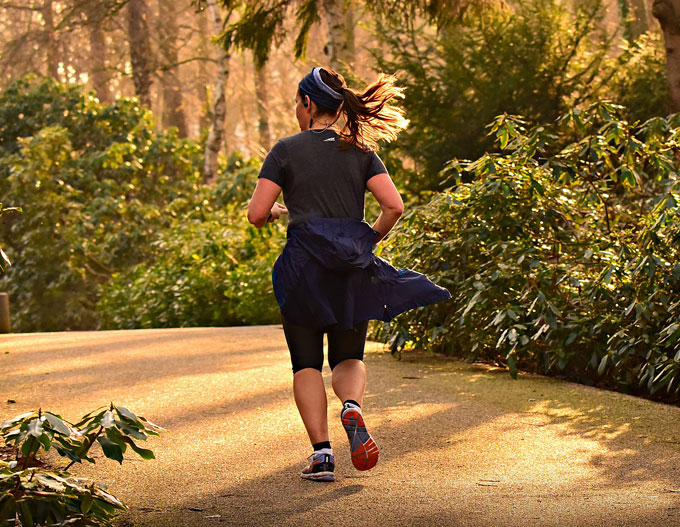
By SABRE
Exercising outdoors brings on a special sense of freedom. Fresh air, sunshine and the feel of your own power can really brighten your attitude while building muscle and cardio strength.
But is running outside safe?
It may seem boring to run on a treadmill, but there are usually no cars, dogs or threats in the gym.
Outdoor athletes encounter all kinds of potential pitfalls, including uneven terrain, uncomfortable weather and all kinds of moving vehicles that are not looking out for pedestrians.
Rather than succumb to fear and give up running outdoors, a good strategy for continuing the activities you enjoy is to develop some safety strategies aimed at risk aversion.
There’s no way to eliminate all dangers — but doing your best to avoid risky situations and prepare for how to deal with emergencies goes a long way to building confidence and improving your outdoor exercise experience.
We’ve put together 6 Tips for How to Stay Safe while Running Outdoors that will help you prepare for the worst while still enjoying the activities you love in the great outdoors.
1. Run in the Daylight (When You Can)
Some runners love the special feeling of running in the dark. But darkness can presents additional potential risks.
Whether you’re on the sidewalk by a busy street or on a trail in the woods, visibility is poor after dark, both for you and others.
Cars pulling out of driveways or parking lots may not expect pedestrians at night, and tree roots, stones and other obstacles will be nearly invisible on the trail after dark.
Some threats and predators find it easier to hide in the shadows at night, waiting for unsuspecting potential victims to jog by.
Running in the daylight is always safer, but committed night owls might consider hitting the gym as their safer option.
If you do find yourself running when it’s dark out, consider some of the next few tips we’ve put together to increase your safety levels.
2. Get Your Group On
One way to take back that night running thrill is to do it with a group.
There is safety in numbers, so if you twist an ankle or encounter creeps, you’ll have someone there to help you.
Remember to dress properly for after dark running in light-colored, reflective clothing so cars will be more aware of your presence.
And even with your buddies, it’s a good idea to have a personal alarm on you in case you fall behind, get separated or are pulled away by an attacker.
(Designed with active users in mind, the Runner Personal Alarm with Adjustable Wrist Strap is our loudest alarm yet at 130 dB. Simply pull the ring to activate this weather-resistant alarm. Audible up to 1,000 feet – the length of three football fields – away, this item helps you attract witnesses and Good Samaritans should you be attacked or injured. The compact design features an adjustable, weather-proof wrist strap, a reflective logo to enhance visibility and a low battery test button indicator to ensure your device is providing maximum safety. The SABRE Runner Personal Alarm: your new favorite workout companion. Courtesy of SABRE and YouTube.)
3. Listen Up
Running is always better with tunes, but leave your headphones at home for your outdoor run.
There are so many variables on a trail or street — cross traffic, emergency vehicles, bicyclists, animals, other pedestrians — you really need to be fully aware of your surroundings to stay as safe as possible.
If you’re zoning out to your killer playlist, you become vulnerable to accidents and predators looking to sneak up behind an easy target.
Being able to hear footsteps, cars, horns and sirens gives you time and space to avoid problems and react quickly.
4. Stay Connected
If you must run alone, even in the daytime, let someone know where you’re running and what time you plan to be home.

Creating a check-in system with a friend is a great plan, with a call or text letting them know when you’ve finished safely.
Always carry your charged cell phone with you, and consider using a GPS tracking app that not only shows your friend your whereabouts but lets you dial for help with just one click if you fall or get into trouble.
5. Use Tools
Pepper spray can be a highly effective safety tool against aggressive dogs and people — if you know how to use it and have practiced.
The main concerns with this option are the blowback effects from the wind and the possibility of an attacker taking your pepper spray to use against you.
The Runner Pepper Gel with Adjustable Strap from SABRE was specifically designed with outdoor athletes in mind.
(PROTECTION IN THE PALM OF YOUR HAND: Lightweight and non-intrusive pepper gel includes an adjustable hand strap for instant access; Perfect for running, this ¾ oz unit provides 35 bursts (5x Other Brands) for protection against multiple threats. Courtesy of CGH149 and YouTube.)
It stays securely strapped to your hand, offers a 12-foot range, encounters virtually no blowback and includes UV marking dye to help with identifying suspects.
Plus, SABRE offers free online training videos to help you feel confident using pepper spray correctly.
6. Know Some Moves
No one is immune from the attacks of criminals.

And outdoor athletes — both male and female — are vulnerable simply because they’re distracted and may have their defenses down.
Knowing a few basic self-defense moves can help you feel more confident about fighting off an attacker.
A personal safety class can teach you how to drop your center of gravity to make it harder for an attacker to throw you off balance, plus how to effectively jab at their eyes, throat and groin until you get an opportunity to run away.
Learning these moves ahead of time makes it more likely you’ll stay calm in an emergency and be able to safely escape.
 Enjoy peace of mind on the run and stay safer with SABRE.
Enjoy peace of mind on the run and stay safer with SABRE.
To Learn More, go to https://www.sabrered.com/pepper-spray-and-personal-safety-products.
Original post https://www.sabrered.com/blog/running-outside-safe-how-stay-safe-while-running.















